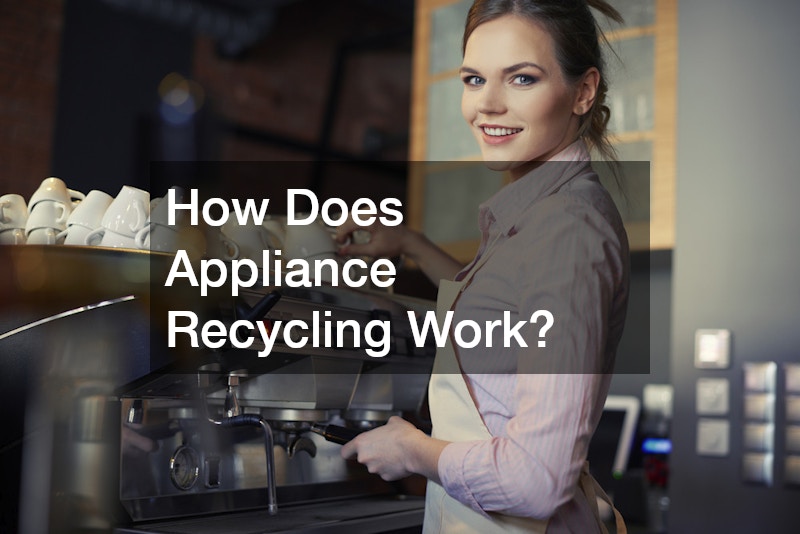Appliance recycling is a crucial component of modern waste management practices due to its significant impact on the environment and conservation of resources. As landfills fill up and the demand for raw materials increases, recycling old appliances becomes ever more essential. This article delves into the steps involved in appliance recycling, offering a deeper understanding of its eco-friendly benefits.
What Are the Steps Involved in Appliance Recycling?
Collection and Transportation
The first step in appliance recycling involves the collection of old and unused appliances from residential, commercial, or designated drop-off locations. Various programs are in place where consumers can easily schedule pickups or drop-offs, often incentivized by local councils.
Once collected, these appliances are safely transported to recycling facilities, minimizing any potential environmental risks during movement.
Transportation of appliances to recycling centers is often done using specialized vehicles to prevent damage and leaks of hazardous substances. Ensuring the safe and efficient transfer of these items is crucial to maintaining the integrity of both the appliances and the environment. Large appliances such as fridges and washing machines require careful handling during transportation due to their size and weight.
Coordination between collection points and recycling facilities streamlines the entire process, reducing delays and associated costs. The transportation phase is a key aspect of appliance recycling logistics, impacting the efficiency of subsequent processes. By working with experienced logistics companies, recycling firms can ensure that this step is executed with precision and care.
Sorting and Dismantling
Once appliances arrive at the recycling facility, they are sorted based on type, size, and material composition. This sorting phase is critical as different appliances contain varying materials that require specific recycling methods. Advanced technology often assists in the sorting process, ensuring accuracy and efficiency.
After the sorting process, appliances undergo dismantling where they are broken down into components. Dismantling is either performed manually or with the aid of machines, a decision that depends on the appliance type and recycling plant capabilities. This step allows for the separation of materials, making it easier to process for recovery later.
The dismantling process also plays a role in environmental conservation by preventing the release of hazardous substances. Proper dismantling techniques ensure that components containing chemicals, like refrigerants, are carefully handled. By controlling these potential pollutants, recycling facilities contribute to safer environmental practices.
Processing and Material Recovery
Following dismantling, the next step is processing and recovering valuable materials such as metals, plastic, and glass from the broken-down components. Metals are particularly valuable in this phase and are extracted for use as raw materials in new manufacturing. Innovative technologies have improved the efficiency of material recovery, extract metal with minimal waste.
The variety of materials retrieved during processing necessitates diverse methods to maximize their reuse potential. For instance, plastics undergo different recycling processes compared to metals to match their intended later use efficiently. The ability to reclaim and repurpose these materials is key to reducing the need for virgin resources and lowering the overall environmental impact.
Recycling facilities aim to achieve high recovery rates to enhance the sustainability of their operations. This is accomplished by continually updating equipment and practices to align with industry advances. By recovering as many materials as possible, recycling processes contribute substantially to a circular economy.
What Happens to Recycled Appliances?
Material Repurposing
Once the materials are recovered from old appliances, they are sent to various industries for repurposing into new products. Metals are commonly melted down and reformed into steel components, which hel8p create new appliances and vehicles. Similarly, plastics can be processed into pellets and used in creating new consumer goods.
The transformation of recycled materials into new products displays the practical benefits of sustainable recycling. By integrating these materials into the manufacturing pipeline, companies reduce their reliance on new material extraction, minimizing environmental footprints. This successful conversion of waste into value-loaded products reflects the economic and environmental promise of recycling.
Collaborations between recycling facilities and manufacturers streamline the flow of materials, aligning with environmental goals. These partnerships underscore the necessity of closed-loop systems, where every end product becomes a resource for future production. Such systems illustrate how appliance recycling propels the advantages of sustainability forward.
Eco-friendly Disposal Methods
Not all components of appliances are recyclable, so they require careful disposal through eco-friendly practices. Components containing hazardous substances must undergo specialized treatment to prevent them from inflicting environmental damage. Safe disposal methods are crucial in minimizing pollution and protecting ecosystems.
Adopting eco-friendly disposal methods cultivates a more sustainable approach to waste management. Recycling facilities often work with government authorities to ensure waste materials are disposed of according to regulatory standards. Such cooperation enhances compliance and fortifies commitment to safe disposal procedures.
The initiative to improve waste disposal methods aligns with global environmental agendas. By continually evolving techniques to manage appliance waste safely, recycling contributes to a gradual decline in waste sent to landfills. This reduces the potential for environmental degradation and fosters a healthier planet.
Role of Regulatory Policies
Government regulations and policies play an influential role in the appliance recycling industry, guiding compliance with environmental standards. Regulations seek to control the handling, treatment, and recovery of waste materials, ensuring recycling is performed responsibly. Policies also offer guidance for establishing clear practices that protect both public health and the environment.
The influence of regulatory policies fosters an increase in innovation within recycling operations. As legislation evolves, recycling facilities adjust to meet stricter requirements, often investing in advanced technologies and updated procedures. This adaptation promotes higher efficiency and effectiveness across the entire recycling process.
Furthermore, regulations provide a framework for incentives that encourage public participation and corporate responsibility in recycling efforts. Through incentives, people are motivated to engage in recycling programs, bringing more materials into the cycle. Thus, regulations not only serve protective roles but also stimulate industry progress and consumer involvement.
.

